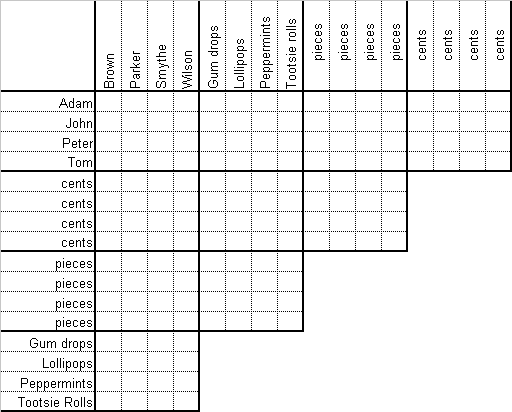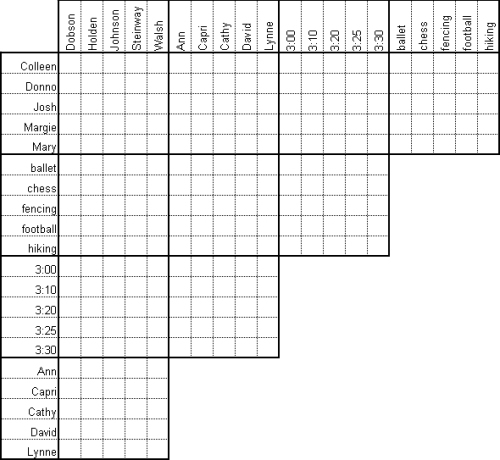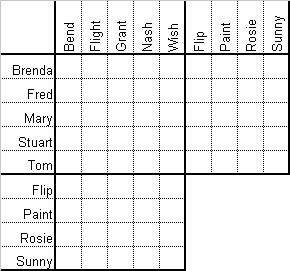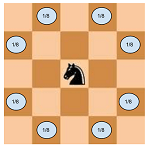Logic Puzzles
-
One Saturday afternoon, four boys visited the local 5 and 10 store to buy candy. Each boy bought just his favorite candy and they all had a different favorite. They each spent under one dollar and they each bought a different amount of their favorite candy. Can you determine each boy’s full name, the type and quantity of candy each boy purchased, and how much each boy spent?
- Peter, whose last name isn’t Smythe, bought one piece less than the boy who bought the Tootsie Rolls but he spent 15 cents more.
- Adam, who spent 35 cents, spent the least. The boy who bought the lollipops spent the most.
- Tom Wilson, who spent 10 cents more than John, spent 60 cents.
- The amount spent by each boy, from the least to the most, was the boy who bought the peppermints, the boy whose last name is Smythe, the boy who bought the Tootsie Rolls, and the boy whose last name is Brown.
- Peter’s last name isn’t Parker.
- The boy who bought ten gum drops, whose last name isn’t Parker, bought the largest quantity. The boy who spent the most bought the smallest quantity.
- The boy who got seven peppermints had two more pieces than the boy who got the lollipops.
Use the grid to help solve the puzzle!
 View SolutionSubmit Solution
View SolutionSubmit Solution- 1,447.4K views
- 1 answers
- 1 votes
-
One day, five couples and their children (each couple had only one child) spent the day at an amusement park. They all enjoyed the day tremendously despite the fact that each child managed to get lost at some point during the day. Using the clues and the grids below, determine the full name of each couple, the name and age of each couple’s child, and where each lost child was found.
- George, whose last name isn’t Smith, is a good friend of Bill Walker, who is not Susie’s father.
- The ages of the children from lowest to highest are the 6 year old, Ann, the one found by the teacups, George’s son, and Jane’s child.
- Michael Charming, whose 10-year-old child is the oldest, helped Stan find his daughter, who is a year younger than Ann, by the carousel. Stan’s last name isn’t Smith.
- The boy found at the ferris wheel is younger than John but older than Ann. Mary is older than Susie but younger than Tom.
- Sally Jackson didn’t find her son at the teacups or the roller coaster. When she looked by the flume, she found Kim’s 7-year-old child.
- Al and Linda’s child, who is 8, is the best friend of Michelle’s daughter, who is two years younger.
Use the grid to help solve the puzzle!
 View SolutionSubmit Solution
View SolutionSubmit Solution- 1,447.7K views
- 1 answers
- 0 votes
-
Five parents pick-up their children at the Puzzlefry Elementary School every Tuesday to bring the kids to their afterschool activity. Colleen and the four other children all attended a different afterschool activity and their parents always arrive at different times (between 3:00 pm and 3:30 pm). Determine each child’s full name, the first name of the parent picking them up (all the parents’ last names are the same as their child’s), the time each was picked up, and the activity each child is being brought to.
- Margie’s best friend’s mother, Mrs. Dobson, arrived before Cathy came to pick up her son. Mrs. Walsh picked up her daughter for fencing.
- Josh Steinway loved football as much as Donno liked chess, and they both liked being the last two to be picked up.
- David Holden picked up his daughter for her hiking as soon as he could, but Lynne was always there before he was.
- Margie liked being the first one picked up but she didn’t take ballet or hiking.
- Lynne’s daughter was not Margie.
- In order of their departure from school: Ann, the girl who took ballet, Mary Holden, the boy who took football, and Capri Johnson.
Use the grid to solve the puzzle!
 View SolutionSubmit Solution
View SolutionSubmit Solution- 1,448.3K views
- 1 answers
- 0 votes
-
John Steve, owner of a club name “The Horse Club”, had a problem. He had five guests coming next week who all wanted to ride. Unfortunately, he only had four horses available. Each of the guests wanted to spend most of their five day stay riding. And to make matters worse, they preferred riding the same horse all week! After scratching his head almost bald, he finally came up with a plan that allowed each guest to ride on four days and on the same horse for at least two of the days. Using the grid and clues below, determine the full name of each guest, on which days each guest rode (each guest rode on four out of five days), and on which horses (the four horses were ridden every day).
- Each horse was ridden by three different people. Brenda, who didn’t ride Paint, rode the same horse for three days and a different one on Monday.
- On Wednesday, the person whose last name is Wish rode Sunny, Mr. Grant rode Paint, Mary rode Rosie, and Flip was ridden by the person whose last name was Bend.
- The horse, Paint, was ridden twice in a row by both Fred, who only rode two horses, and the one who rode Flip on Friday.
- Ms. Nash and Stuart each rode Sunny on one day. Tom rode three different horses.
- On Tuesday, Brenda didn’t ride, Mr. Grant rode Flip, Mary rode on the same horse that she rode for the rest of the week, Stuart Bend rode, and Tom rode Paint.
- Brenda, the woman who rode Sunny on Monday, and Mr. Flight all rode Rosie. Mary didn’t ride on Thursday.
Use the grids to help solve the puzzle!

 View SolutionSubmit Solution
View SolutionSubmit Solution- 1,448.9K views
- 1 answers
- 0 votes
-
Given the size of the chess board and initial position of the knight, what is the probability that after k moves the knight will be inside the chess board.
Note:-
1) The knight makes its all 8 possible moves with equal probability.
2) Once the knight is outside the chess board it cannot come back inside.
Puzzlefry added Info-
This challenge is originally from a blog post of crazyforcode.com published under the CC BY-NC-ND 2.5 IN licence.View SolutionSubmit Solution- 1,451.1K views
- 2 answers
- 1 votes
-
Imagine that you’re about to set off walking down a street. To reach the other end, you’d first have to walk half way there. And to walk half way there, you’d first have to walk a quarter of the way there. And to walk a quarter of the way there, you’d first have to walk an eighth of the way there. And before that a sixteenth of the way there, and then a thirty-second of the way there, a sixty-fourth of the way there, and so on.
Ultimately, in order to perform even the simplest of tasks like walking down a street, you’d have to perform an infinite number of smaller tasks—something that, by definition, is utterly impossible. Not only that, but no matter how small the first part of the journey is said to be, it can always be halved to create another task; the only way in which it cannot be halved would be to consider the first part of the journey to be of absolutely no distance whatsoever, and in order to complete the task of moving no distance whatsoever, you can’t even start your journey in the first place.
View SolutionSubmit Solution- 1,448.9K views
- 1 answers
- 0 votes
-
A crocodile snatches a young boy from a riverbank. His mother pleads with the crocodile to return him, to which the crocodile replies that he will only return the boy safely if the mother can guess correctly whether or not he will indeed return the boy. There is no problem if the mother guesses that the crocodile will return him—if she is right, he is returned; if she is wrong, the crocodile keeps him. If she answers that the crocodile will not return him, however, we end up with a paradox: if she is right and the crocodile never intended to return her child, then the crocodile has to return him, but in doing so breaks his word and contradicts the mother’s answer. On the other hand, if she is wrong and the crocodile actually did intend to return the boy, the crocodile must then keep him even though he intended not to, thereby also breaking his word.
The Crocodile Paradox is such an ancient and enduring logic problem that in the Middle Ages the word “crocodilite” came to be used to refer to any similarly brain-twisting dilemma where you admit something that is later used against you, while “crocodility” is an equally ancient word for captious or fallacious reasoning
View SolutionSubmit Solution- 1,451.1K views
- 1 answers
- 0 votes
-
Monday Tuesday and Wednesday are three sisters.
What’s their father’s name?
View SolutionSubmit Solution- 1,449.2K views
- 1 answers
- 0 votes
-
A man fell in a 30 meter deep well, in one day he climbs 4 meters up and slips 3 meters down. How many days would it take for him to come out of the well?
View SolutionSubmit Solution- 1,494.9K views
- 4 answers
- 1 votes
-
- 1,451.5K views
- 1 answers
- 0 votes


